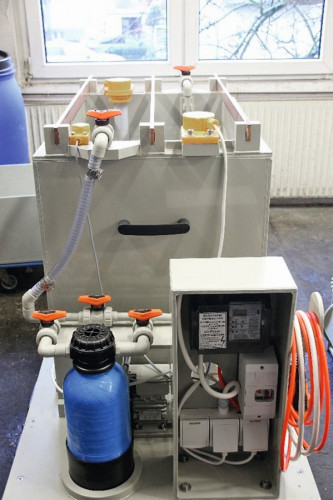Chrome layers play an important role in both decorative and functional electroplating. In some areas of decorative coating, trivalent chromium plating has already been successfully implemented despite the more demanding process control compared to hexavalent electrolytes.
In contrast to hexavalent electrolytes, one advantage in addition to the lower risk to health is that the coating process can be continued even after a brief interruption in the power supply. We have taken advantage of this property in the development of our new electrolyte SAPHIR 2050. SAPHIR 2050 is an innovative drum process for the deposition of chromium. It eliminates the need for time-consuming and tedious mounting of small parts, so that chrome plating can be carried out immediately after barrel nickel plating. A visually appealing, bright bright chrome layer is deposited (see Fig. 1).
 Fig. 1: Samples that were coated in the technical center using SAPHIR 2050 (all Fig. Kiesow)
Fig. 1: Samples that were coated in the technical center using SAPHIR 2050 (all Fig. Kiesow)
|
Limit values |
Optimum |
|
|
SAPHIR 2000 donor |
65 - 75 ml/l |
70 ml/l |
|
SAPHIR 2000 Conductor |
270 - 300 g/L |
280 g/L |
|
SAPHIR 2000 Improver |
40 - 50 ml/l |
45 ml/l |
|
SAPHIR Additive 950 |
10 - 15 ml/l |
13 ml/l |
|
Temperature |
50 - 55 °C |
52 °C |
|
pH value |
3,2 - 3,6 |
3,4 |
|
Exposure time |
30 - 60 min. or as required |
|
|
Density |
23 °Be |
|
 Fig. 3: Tank for drum tests directly on the system. The tank is equipped with a pump, heater and ion exchanger column
Fig. 3: Tank for drum tests directly on the system. The tank is equipped with a pump, heater and ion exchanger column
The process can be controlled very well with various additives. Dosing is mainly in liquid form. The most important additives and operating parameters are listed in Table 1. The SAPHIR 2050 was successfully tested both in the technical center and at the customer's premises. Coating thicknesses of 0.1-0.3 µm chromium are achieved in 30 minutes. Due to the very good throwing power, small parts can be completely coated in the drum, as shown in Figure 2. In order to test the SAPHIR 2050 in practice, a transportable test tank was built to enable the process to be put through its paces directly on the system (Fig. 3). The cobalt-free SAPHIR 2050 electrolyte works in a wide working range and the additives can be easily analyzed. Both the electrolyte and rinsing water can be disposed of internally in accordance with a specially developed regulation. The process makes it possible to simplify workflows and speed up processes.


